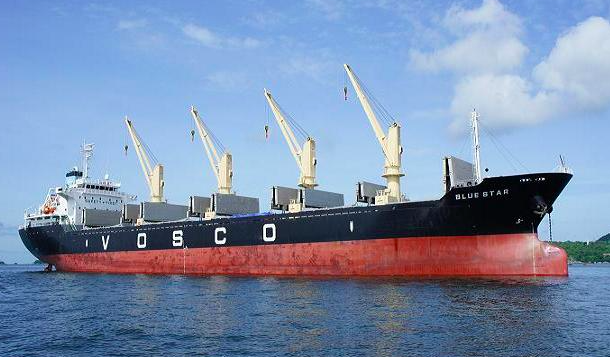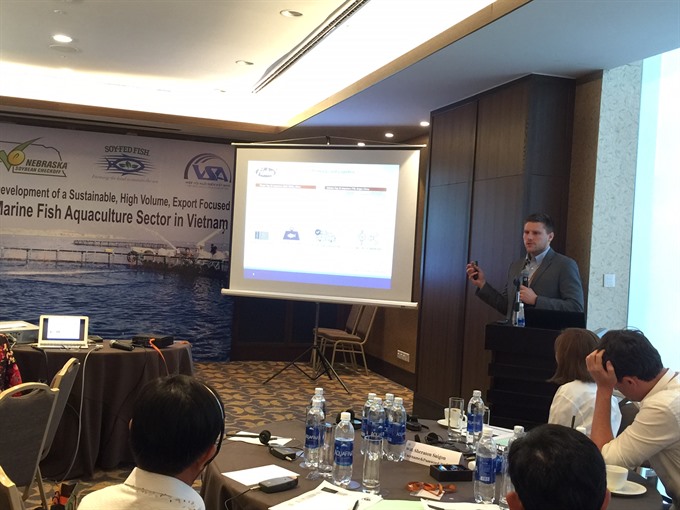 Economy
Economy

Việt Nam’s exports of marine aquaculture produce is expected to reach US$12-13 billion by 2020 and $30-35 billion by 2030, according to the Việt Nam Sea Culture Association.
 |
| Matt Brooker, business development manager of the Fishin’ Company, a US seafood importer, talks about seafood demand at a workshop held in HCM City on May 5. — VNS Photo |
HCM CITY — Việt Nam’s exports of marine aquaculture produce is expected to reach US$12-13 billion by 2020 and $30-35 billion by 2030, according to the Việt Nam Sea Culture Association.
Nguyễn Hữu Dũng, the association’s president, said with its long coastline and more than 3,000 islands and archipelagos, Việt Nam has excellent prospects in marine aquaculture, especially in farming fish, mollusc, and seaweed.
Speaking at a workshop on Developing a Sustainable, High Volume, Export-Focused Marine Fish Aquaculture Sector in Southeast Asia in HCM City on May 5, Dũng said since 2012 Việt Nam had been among the top 10 marine aquafarming countries in the world, with its exports increasing significantly.
Nguyễn Bá Sơn of the General Department of Fisheries said marine fish output had gone up to 28,300 tonnes last year from 15,700 tonnes in 2010, with Khánh Hòa, Quảng Ninh, Kiên Giang and Bà Rịa-Vũng Tàu being the main farming areas.
There are many species suitable for marine aquaculture, he said, listing the main species farmed in floating net cages as grouper, snapper, sea bream, yellowtail, kingfish, and wrasse.
The industry has achieved early success but faces certain constraints like small scale, outdated technologies, and lack of links between farms and the feed, seed, processing, consumption, and distribution systems, he said.
The lack of policies and preferential support to attract investments are other challenges, he said.
Dũng said the world population was growing rapidly, and was expected to reach 9.7 billion by 2050 from 7 billion in 2011.
By then demand for seafood-based protein would increase by 1.7 times from now, with farmed items accounting for 62 per cent, offering Southeast Asia, including Việt Nam, a good opportunity, he said.
But to capitalise, the country needs to develop a start-up strategy for the marine aquaculture industry with breakthrough policies, he said.
The Government should revise Decrees 67/2014 and 89/2015 to add marine farms and activities to the list of beneficiaries of preferential credit, build large-scale breed stock production establishments, and invest in or upgrade feed facilities, he said.
He also suggested that the Government should have a marine environment monitoring and regulation programme and another programme to regenerate marine eco-systems and train staff and professional workers.
This would help develop a large aquafarming industry with advanced environment-friendly technologies to ensure sustainable development, develop both sea- and land-based aquaculture and value chains and expand both export and domestic markets by ensuring the highest quality, traceability, branding and marketing and others, he said.
Under the strategy, annual marine aquaculture output (of shrimp and lobster, marine fishes, seaweed, and mollusc) is expected to reach 4.7 million tonnes by 2030, and exports, $30-35 billion, he said.
Lukas Manomaitis, the US Soybean Export Council’s aquaculture programme lead technical consultant in Southeast Asia, said there are both immediate and medium- to long-term opportunities for those interested in industrial marine fish production in Southeast Asia.
The region would move to offshore cage farming, which requires advanced cage technology to withstand harsher conditions, though many areas actually have relatively calm waters, he said.
Talking about seafood demand in the US, Matt Brooker, business development manager of the Fishin’ Company, a US seafood importer, said per capita consumption has increased significantly and would continue to rise.
But to be able to penetrate the US market, suppliers must develop aquaculture species and products that meet all food safety, sustainability, social compliance and traceability standards, he said.
They should provide consistently assured supply and familiar products that have flavour profiles consistent with what the US consumer expects, and be competitive in terms of pricing, he added. — VNS